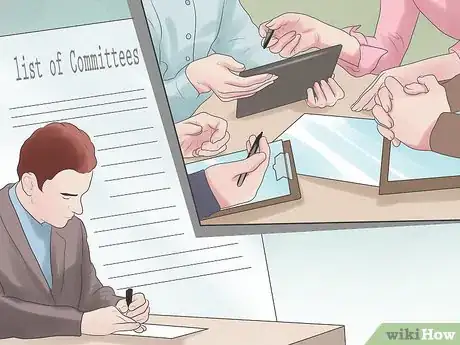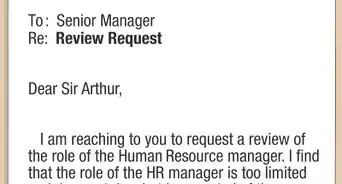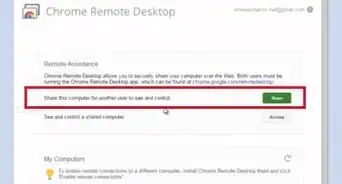This article was co-authored by Clinton M. Sandvick, JD, PhD. Clinton M. Sandvick worked as a civil litigator in California for over 7 years. He received his JD from the University of Wisconsin-Madison in 1998 and his PhD in American History from the University of Oregon in 2013.
There are 9 references cited in this article, which can be found at the bottom of the page.
wikiHow marks an article as reader-approved once it receives enough positive feedback. In this case, 81% of readers who voted found the article helpful, earning it our reader-approved status.
This article has been viewed 208,126 times.
Unions are employee organizations that bargain for better wages, benefits, and conditions for the workers they represent. [1] [2] Though often frowned on by employers, the right to unionize is protected by law.[3] Forming a union is a democratic process that requires employees to vote to unionize. If a majority of your coworkers agree, you can affiliate with an existing union or create an independent union of your own.
Steps
Getting Started
-
1Talk to your co-workers about unionizing. Ultimately, a majority of your co-workers will need to vote to establish a union. By talking to your co-workers, you can gauge whether your fellow employees are likely to support a union election. Talking is also the best way to find out what changes your co-workers would like to see, and for you to share your ideas about how unionization can effectuate those changes.
- Keep your discussions quiet and private.[4] Although the National Labor Relations Act guarantees the right to discuss union membership during non- work time in non work areas (like an employee lounge)[5] , keeping these discussions discreet helps avoid conflict between the management and pro-union employees.
- Your co-workers must find you to be trustworthy and competent, so study up on union issues, like federal and state labor law, the benefits of unions, and common employer tactics used to discourage organization.[6] When a co-worker has a question or challenges your position, you should ready to answer quickly and confidently. To successfully organize, you must inspire and persuade you peers to follow your leadership.
-
2Find out if you can join a pre-existing union. There may already be a union you can join that represents your industry. These organizations can guide you through the process of organizing a union at your workplace. Most U.S. labor organizations are organized under the American Federation of Labor - Congress of Industrial Organizations or the Change to Win Federation. There are also independent unions that are not affiliated with either umbrella organization, such as the International Longshore & Warehouse Union, United Electrical Workers, and Industrial Workers of the World.
- You can also locate local unions by searching online or in the phone book under "Labor Organizations." Keep in mind that the name of the union doesn't matter; meat packers commonly belong to the United Steel Workers. Contact your local unions to find out what industries they represent.[7]
Advertisement -
3Contact a union organizer. If you and your co-workers decide that you would like to organize under an existing union, contact a union organizer at a pre-existing union to help organize a union at your workplace. [8]
- Alternatively, if you can form a new independent union that is recognized by the National Labor Relations Board (NLRB) without working with an existing union. Be aware that the cost of running a union and the complexities of labor law may make forming a new union impractical.[9]
Organizing at Work
-
1Form an organizing committee. Whether you are working with the assistance of a union organizer from a pre-existing union or trying to start an independent union, start by assembling an organizing committee. Committee members should be prepared to do research the benefits of unionization and to educate and persuade their co-workers to support the union. Find like-minded co-workers who are interested in helping organizing your unionization campaign. Try to find a selection of members who represent a good cross-section of the company, including people who represent different:
- Departments within the company;
- Shifts;
- Racial and ethnic backgrounds; and
- Genders.[10]
-
2Gather information about the employees and workplace. You will need to gather information about the workplace, which may be useful to the union or the NLRB in the future. In gathering information, research your company online and speak to co-workers who may have the information you are missing.
- Describe the workplace structure, including the different departments, work areas, jobs, and shifts.
- Collect information from each employee on a spreadsheet with each person's name, address, phone number, shift, job title, and department.
- Assemble information about your employer, including other locations, parent companies and subsidiaries, products, major customers, and union history.[11]
-
3Formulate an issues program.[12] An issues program is like the organizing committee's mission statement, and should include the improvements that the committee hopes to achieve through unionization, such as higher wages, better benefits, and/or improved working conditions. Be sure to highlight your desired improvements when discussing your campaign to unionize with your co-workers.
- Research the wages and benefits that people in your industry receive in your state and elsewhere in the country when they are unionized versus when they are not represented by a union. Have these statistic handy during discussions.
-
4Prepare for anti-union tactics from your employer. Because unions give more power to workers to negotiate for better pay and working conditions, they take some power away from employers. For this reason, employers often try to discourage union organization. Common discouragement tactics include:
- 'Scare tactics'. Employers might announce that they will refuse to negotiate with the union. However, under federal law, employers are required to negotiate with the union. Employers might threaten the jobs or benefits of pro-union employees, or pressure supervisors to manipulate or harass others. These tactics are abusive and illegal under federal law. Employers might also try to discourage participation by making a big deal about how much unions cost. You can share the counterargument that union dues are a minor expense compared to the positive impact a union can have. If your employer engages in illegal tactics, contact a union representative or the NLRB and ask what actions you should take.
- 'Love tactics'. Some employers try to convince their employees that a union isn't necessary. Common love tactics include apologizing for past wrongs and promising better treatment in the future; and making sudden changes in working conditions, employee benefits, and relationships between employees and managers. Employers hope that by making some small changes, their employees will become complacent and lose their motivation to unionize.
Holding an Election
-
1Collect signatures. If you are working with an established union, you will want to distribute and collect authorization cards, also called "A cards." The union should provide you with pre-printed A cards. If you are working without independently, you will need to circulate a petition. Get signatures from your co-workers who are not supervisors or managers, since supervisors and managers are not eligible for union representation.
- If you collect signatures or cards from at least 30% of the employees, the NLRB will organize a union election.[13]
- If you collect signatures or cards from more than 50% of the employees, you can ask your employer to waive an election and begin acknowledging the union leadership immediately.
- If at least 50% of the employees sign, and the employer will not waive the election, the NLRB can step in and mandate the creation of a union if it investigates and determines that the employer is engaging in actions to prevent a fair election.
-
2File an election petition. You will need to fill out and file this Petition with the NLRB. You must also fill out and file this Certificate of Service stating that you gave notice of the petition to your employer.
- The NLRB will also need to your authorization cards or petition signatures from at least 30% of your co-workers. The NLRB will ask your employer for a list of its employees, and compare the names on the list to the signatures you have submitted.
-
3Vote in the election. It will take the NLRB at least several weeks to determine who is eligible to vote and to schedule an election.[14] The NLRB will then set up a polling area, usually on the employer's property, and supervise the election. Employees vote by casting paper ballots, which are counted on the spot at the end of the voting period. Voting is done by "secret" ballot, so your employer will not know which employees voted to unionize.[15] If at least 50% of the employees vote to form a union, a union is formed.
- In some cases, the NLRB may elect to have employees vote by mail.[16]
-
4Negotiate your first contract. Your first goal after the election is to negotiate a union contract between the employer and the union, which covers everything from wages to how disputes will be handled in the future.[17] If a bargain does not come easily, the union will need to put pressure on the employer to meet the union's demands by mobilizing the employees.
- Mobilization techniques might include writing letters or filing grievances, filing an unfair business practices lawsuit, organizing attendance at public meetings, holding a publicity campaign to get support from the community, and even going on strike.[18]
Warnings
- This article is intended as legal information and does not provide legal advice. If you need legal advice, contact a licensed attorney.⧼thumbs_response⧽
References
- ↑ http://www.bls.gov/opub/mlr/2013/04/art2full.pdf
- ↑ http://www.bls.gov/news.release/pdf/ebs2.pdf
- ↑ http://www.nolo.com/legal-encyclopedia/free-books/employee-rights-book/chapter15-7.html
- ↑ http://www.ueunion.org/org_steps.html
- ↑ http://www.nolo.com/legal-encyclopedia/free-books/employee-rights-book/chapter15-7.html
- ↑ http://www.laboreducator.org/gamplan4.htm
- ↑ http://www.nolo.com/legal-encyclopedia/free-books/employee-rights-book/chapter15-7.html
- ↑ http://www.ueunion.org/org_steps.html
- ↑ http://www.nolo.com/legal-encyclopedia/free-books/employee-rights-book/chapter15-7.html
- ↑ http://www.ueunion.org/org_steps.html
- ↑ http://www.ueunion.org/org_steps.html
- ↑ http://www.ueunion.org/org_steps.html
- ↑ http://www.canmybossdothat.com/category.php?id=247
- ↑ http://www.ueunion.org/org_steps.html
- ↑ https://www.nlrb.gov/sites/default/files/attachments/basic-page/node-3040/Form%20NLRB-5547%20-%20Election%20and%20Post-Election%20Procedures.pdf
- ↑ https://www.nlrb.gov/sites/default/files/attachments/basic-page/node-3040/Form%20NLRB-5547%20-%20Election%20and%20Post-Election%20Procedures.pdf
- ↑ http://www.ueunion.org/org_steps.html
- ↑ https://www.mackinac.org/8291.
About This Article
To form a union, talk to your coworkers in private about how unionizing can benefit them. Once you're confident that a majority would vote in favor, seek out a union organizer who can direct you in the first steps to unionizing. Then, form an organizing committee with your coworkers that will represent all union employees. The committee will need to formulate an issues program stating what you are fighting for, like higher wages or increased benefits. For information from our litigator reviewer on how to hold union elections, scroll down.








































































